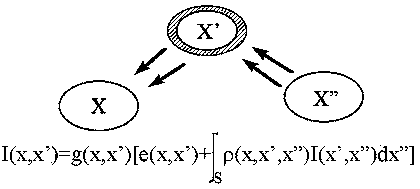The Rendering Equation (à la Kajiya - Siggraph 86)
An attempt to unify rendering so that all rendering had a basic model as a basis.
![]()

where:
-
I ( x , x' ) is the intensity of light passing from point x' to point x.
-
g ( x , x' ) is the visibility between x and x'. If they are occluded, this is zero, otherwise it varies as the inverse square of the distance between them. The part right to that expression is the : the "unoccluted two point transport intensity".
-
e ( x , x' ) is the transfer emittance from x' to x. It is related to the intensity of any light self emitted by point x' in the direction of x
-
r ( x , x' , x'' ) is the scattering term or bidirectional reflectivity with respect to directions x' and x''. It is the intensity of the energy scattered towards x by a surface point located at x' arriving from point or directions x''. The "Unoccluted three-point transport reflectance" Related to the BRDF
-
S represents all points on all surfaces in the scene
-
i.e. the transport intensity from x' to x is the sum of emitted light from x' to x and all light from x'' that eventually gets to x through x'.
This is of course a recursive definition !
Complexity => practical solution are aproximations
View Independant statement of the problem
-
solutions can be view independant (radiosity) or not (raytracing)
we can rewrite this equation
as
![]() where R
is the linear integral operator
where R
is the linear integral operator
rearranging terms gives: 
.
Local Reflection Models
.
only first 2 terms are used
X is the eyepoint
![]()
the g(epsilon) term is non-zero only for light sources
R1 operates on (epsilon) rather than g, so shadows are not computed
Basic Ray Tracing
![]()
Radiosity
- dB(x') is the radiosity of surface element dx'
- p0 is p( x , x' , x'' ) and is constant
- H(x') is the energy incident on the surface element dx'
The Extended Two-Pass Algorithm (Sillion 1989)
.
The general equation used is:
![]()
p(x, x', x'') = pd(x') + ps(x, x', x'') bidirectional diffuse specular reflectivity function
In the first pass, extended form factors are used to compute diffuse to diffuse interaction that has any number of specular transfers inbetween
extended form factors: Diffuse - specular* - diffuse
The 2nd pass uses standard ray tracing to compute specular transfer